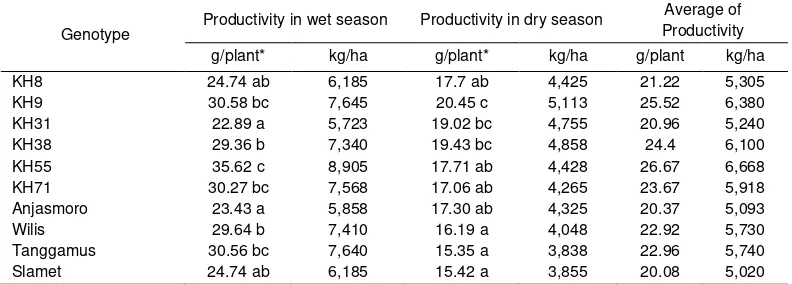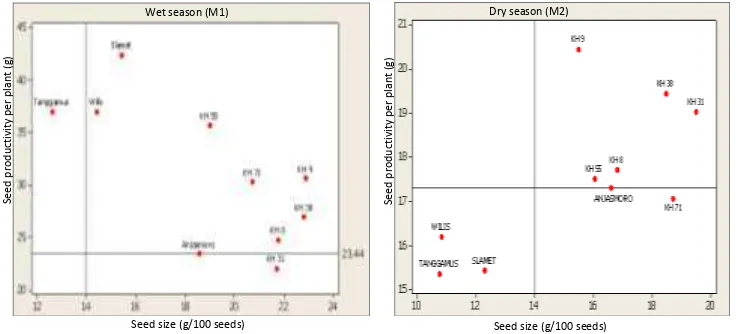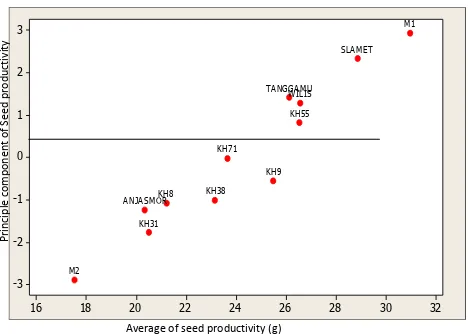220 Proceedings of The 7th ACSA Conference 2011
Productivity of Several Lines of Soybean in Majalengka,
West Java, Indonesia
Alia Astuti
a, Ence Darmo Jaya Supena
a,b, Suharsono
a,b,*a
Department of Biology, Bogor Agricultural University, Indonesia b
Research Center for Bioresources and Biotechnology, Bogor Agricultural University, Indonesia *Corresponding author: PPSHB IPB, Gd PAU, Jl. Kamper, Kampus IPB Darmaga Bogor 16680, Indonesia
Tel: +62 251 8621257; fax: +62 251 8621724. E-mail: [email protected]; [email protected]
Abstract
Soybean (Glycine max L. Merr) is a very important crop in Indonesia. The creation of new elite varieties is one approach to increase the national production of soybean. We have developed several potential lines of soybean to be released as a new varieties. Before releasing as new varieties, the productivity of these lines has to be evaluated in several locations. Therefore the objective of this research was to evaluate the productivity of six lines of soybean resulted from the cross between Slamet and Nokonsawon varieties, i.e. KH8, KH9, KH31, KH38, KH55, and KH71 in Majalengka, West Java, Indonesia. Four national elite varieties i.e. Anjasmoro, Slamet, Tanggamus and Wilis were used as standard. The experiment was conducted in two seasons by using randomized block design, with three blocks as replication. The result showed that based on the seed production per plant in two seasons, all six lines have higher productivity than Anjasmoro variety. The seeds of these six lines are bigger than that of standard varieties. Analysis of production stability in two seasons showed that KH71 is the most stable genotype in Majalengka. By comparing to Anjasmoro variety in two seasons, all six lines have a potential to be released as new varieties with high productivity and big seed.
Keywords: lines, productivity, seed size, soybean
Introduction
Soybean (Glycine max L. Merr) is a very important crop in Indonesia. Every year, Indonesia
imports more than 1.2 million tons of grains of soybean for food. The creation of new elite varieties is one approach to increase the production of soybean in Indonesia. The creation of tolerant varieties to acid soil containing high concentration of aluminum is very important to extend the cultivation onto the marginal land with with this condition. Sunarto (1995) had created a variety of Slamet which is tolerant to acid soil. Eventhough variety of Slamet has a high productivity and is a tolerant to acid soil, it has a relatively small seeds and its hilum is black which are undesirable traits for tofu and tempeh industry. To improve these traits, we had crossed this variety with Nokhonsawon variety which has a big seeds, then followed by selection based on high productivity
and seed size traits (Suharsono et al., 2006, 2007; Jambormias et al., 2011). From this cross, we
obtained 18 potential lines to be released as a new variety.
Proceedings of The 7th ACSA Conference 2011 221 Materials and Methods
Six lines of soybean i.e. KH8, KH9, KH31, KH38, KH55, and KH71 were used in this experiment. Four national cultivars i.e. Slamet, Wilis, Anjasmoro and Tanggamus were used as standard. The experiment was carried out in Randomized Block Desain with three replications, so this experiment had 30 experimental units or plots. The size of plot is 4 m x 5 m, planting distance is 40 cm x 20 cm with two plants per hole, so the productivity per hectar is productivity per plant x 250,000. The plants were fertilized by 10 tons of manure, 100 kg urea, 150 kg SP3, and 100 kg KCl per ha in the beginning of cultivation. The evaluation of plant productivity was carried out by sampling. For sampling, 10 plants were ramdomly chosen per plot. Seed size was mesured by weighing 100 dry seeds which were ramdomly chosen.
The cultivation was carried out in two seasons, i. e. wet and dry seasons. The cultivation in wet season (season I) was caried out in December 2009 - March 2010, and in dry season was done in May - August 2010. The data of seed productivity per plant and seed size were analyzed by Duncan Multiple Range Test. The clustering of genotype based on seed productivity per plant and seed size was carried out by Important Performance Analysis (IPA). The analysis of stability of seed productivity in two season was carried out by Additive Main Effect Multiplicative Interaction (AMMI).
Results and Discussion
Seed productivity and seed size
The seed productivity of all genotype (KH lines and standard varieties) in the wet season was very high, between 22.9 and 35.6 g per plant, equivalent to 5.7-8.9 tons per ha. This productivity is higher than that in dry season that is between 15.35 and 20.45 g per plant equivalent to 3.8- 5.1 tons per ha (Table 1). Based on the description of Ministry of Agriculture (Deptan, 2011), the productivity of Anjasmoro, Slamet, Tanggamus, and Wilis is 2.25-2.3, 2.26, 1.22, and 1.6 tons per ha respectively. This productivity is lower than that of the same variety in Majalengka that is more than 5 tons per ha (Table1). This result indicates that the environment of cultivation in Majalengka was very favorable for soybean. The soil of this experiment has a pH 5.9 and contains 65,3 ppm of P which are very favorable for soybean growth.
Table 1. The productivity of several genotype in wet and dry seasons
Genotype Productivity in wet season Productivity in dry season
Average of Productivity
g/plant* kg/ha g/plant* kg/ha g/plant kg/ha
KH8 24.74 ab 6,185 17.7 ab 4,425 21.22 5,305
KH9 30.58 bc 7,645 20.45 c 5,113 25.52 6,380
KH31 22.89 a 5,723 19.02 bc 4,755 20.96 5,240
KH38 29.36 b 7,340 19.43 bc 4,858 24.4 6,100
KH55 35.62 c 8,905 17.71 ab 4,428 26.67 6,668
KH71 30.27 bc 7,568 17.06 ab 4,265 23.67 5,918
Anjasmoro 23.43 a 5,858 17.30 ab 4,325 20.37 5,093
Wilis 29.64 b 7,410 16.19 a 4,048 22.92 5,730
Tanggamus 30.56 bc 7,640 15.35 a 3,838 22.96 5,740
Slamet 24.74 ab 6,185 15.42 a 3,855 20.08 5,020
*the number followed by the different letter in the same column is significantly different.
222 Proceedings of The 7th ACSA Conference 2011
national variety with a potential yield more than 5 tons per ha. In wet season, KH55 line has a highest productivity, and in dry season KH9 has a highest productivity.
If we compare between wet and dry seasons, all genotypes have a higher yield in wet season than in dry one. In this experiment, the precipitation during wet season in Majalengka was about 411,53 mm/month, and during dry season was about 202 mm/month. Based on Calvino & Sadras (1999), the precipitation more than 300 mm/month is better for production of soybean.
In average, all lines and Anjasmoro variety have a big seed, and bigger than the seeds of Wilis, Tanggamus and Slamet varieties (Table 2). The big size is very important in the production of tofu because the rendement is depend on the endosperm, and the endosperm of bigger seeds is bigger than small ones. So, based on the size of seeds, all lines have a potential to be released as a big seed varieties. As the yield, the size of seeds was also bigger in the wet season than that in dry ones. The size of seeds may be affected by the enironment of growth. KH31 and KH38 have bigger seeds compared to other genotypes.
Table 2. The size of seed of several genotype in two seasons
Genotype compared to Anjasmoro variety. In dry season, KH8, Kh31 and KH38 lines have higher productivity and seed size compared to Anjasmoro variety (Figure 1). This result indicated that KH8 and KH38 lines are consistently better than Anjasmoro variety.
Proceedings of The 7th ACSA Conference 2011 223
Analysis of stability of seed productivity in two seasons showed that KH71 is the most stable genotype in Majalengka. KH9, KH38 and KH55 lines were more stable than Anjasmoro variety in wet and dry seasons than Anjasmoro Variety (Figure 2). If we consider to the seed productivity, the size of seeds and the stability of seed productivity, KH38 and KH71 are a potential lines to be
Figure 2. Stability of seed productivity in wet and dry season of soybean in Majalengka. M1= wet season, M2= dry season.
Acknowledgement
This research was financially supported by I-εHERE B2c IPB entitledμ ―Test of adaptability of several elite lines of soybean in several locations in the frame of the creation of new elite cultivars‖, contract ζoμ 13/13.24.4/SPP/I-MHERE/2010 on behalf of Suharsono.
References
Calvino PA, Sadras VO. 1999. Interannual variation in soybean yield: interaction among rainfall, soil depth and crop management. Field Crops Research 63: 237-246.
[Deptan] Departemen Pertanian. 2011. Daftar varietas unggul kedelai, http://pangan.litbang.deptan.go.id/index. php?bawaan=varietas/gerbang&proses=daftarstok&komoditas=05025&varietas=1[05 Juli 2011]. Jambormias E, Sutjahjo SH, Jusuf M, Suharsono. 2011. Using information from relatives and path analysis to
select for yield and seed size in soybean (Glycine max L. Merrill). Sabrao J. Breeding Genet 43 (1): 44-58
Suharsono, Jusuf M, Paserang AP. 2006. Analisis ragam, heritabilitas, dan pendugaan kemajuan seleksi populasi F2 dari persilangan kedelai kultivar Slamet x Nokonsawon. J Tanaman Tropika 9:86-94. Suharsono, Jusuf M, Dasumiati. 2007. Analisis ragam, dan seleksi populasi F3 dari persilangan kedelai kultivar
Slamet x Nokonsawon. J Tanaman Tropika 10: 21-28.


